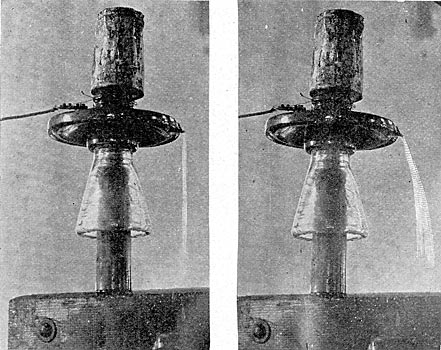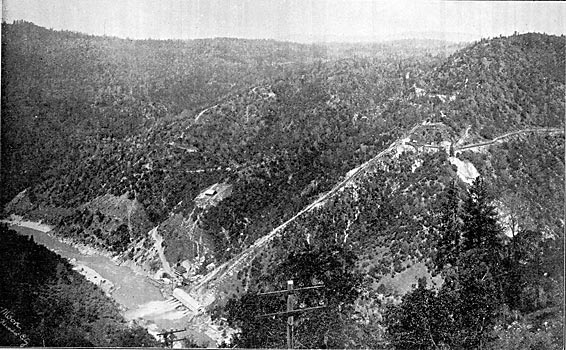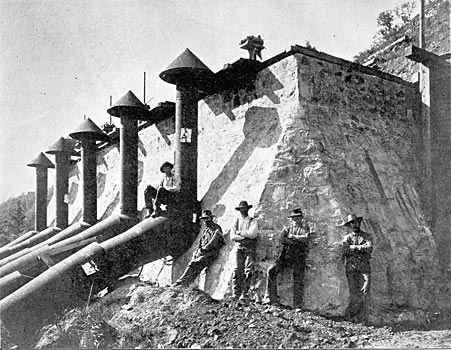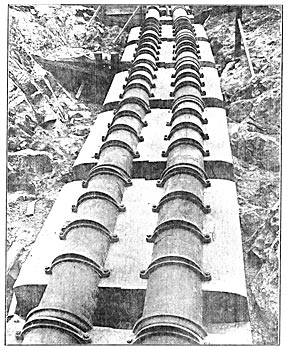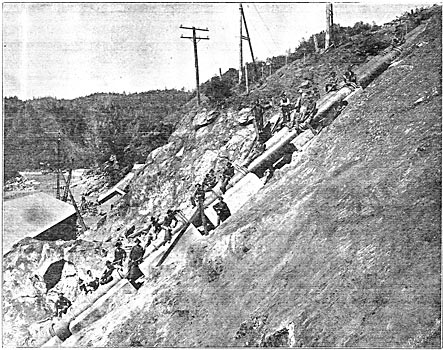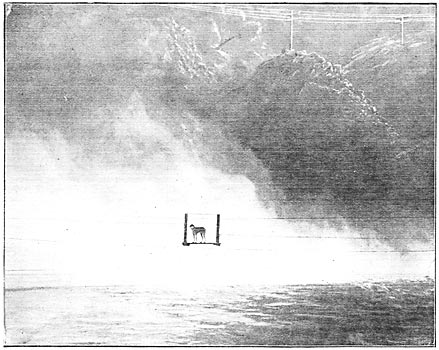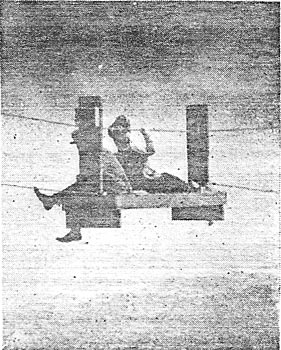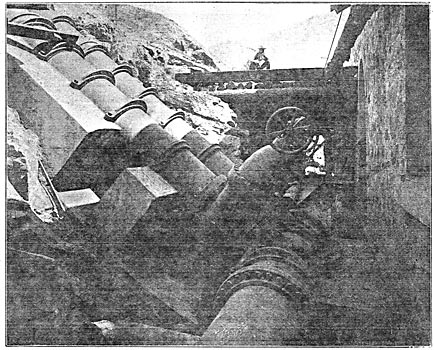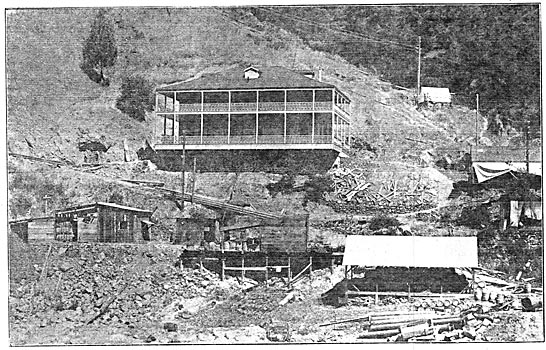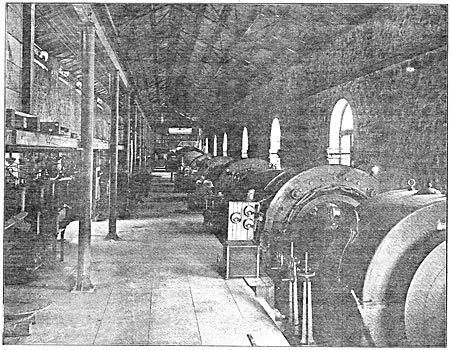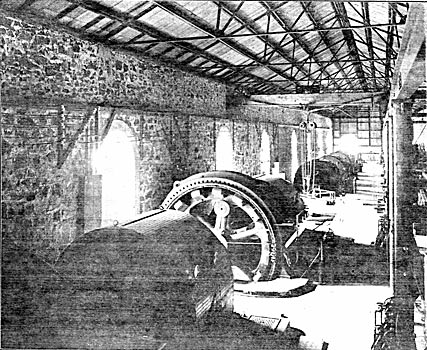[Trade Journal]
Publication: The Journal of Electricity, Power and Gas
San Francisco, CA, United States
vol. 11, no. 7, p. 159-168, col. 1-2
·
·
[Missing text]
·
·
most pronounced in winter when insulators, pins, cross arms and poles became soaked with water and electrical breakdowns became inevitable. All would have been well had even the insulator alone remained dry, but the dripping of water from its exposed portions, and the seepage along its under surfaces gave rise to electrical leakages that were the sure forerunners of trouble. But finally some one in the laboratory of the Stanley Electric Manufacturing Company at Pittsfield, Mass., suggested that possibly the condition might be improved if a rim be placed around the edge of the top piece of the insulator, so that the rain would be collected, and run off as a solid stream through a spout. This was done, and while, of course, an ordinary manner when the insulator was subject to no electrical pressure, the water was scattered outwardly as a spray when it was subjected to a high potential charge. The accompanying halftones, reproduced from photographs taken by Mr. E. E. Stark, illustrate the effect very prettily. A Locke insulator, such as that used on the Bay Counties' high tension lines, was mounted on a pin and cross arm after the customary manner, and a leaking tin can, placed on its top, gave improvised rain. The first engraving shows how the water falls in a solid stream when no electrical potential is on the insulator; the second shows how the same stream is scattered when a potential of 40,000 volts is applied to the insulator — scattered because the particles of water have each become electrified to a like polarity, and "like electricities repel." As a result, the under portions of the insulators are always dry and transmission at extremely high potentials becomes an assured and successful reality.
| |||
| At No Voltage (Left) At 40,000 Volts (Right) |
But to resume our story, the other road referred to as leaving Dobbins goes past Lake Frances — the company's principal reservoir, and on down to Colgate, whence the transmission lines radiate to the east and the west to the various points of service. One of these lines, which is of aluminum, stranded like a rope, and barely 1/4-inch in diameter, goes to Sacramento, sixty-one miles distant, and over this line energy to the amount of 3000 horsepower may be transmitted whenever desired at a pressure of 40,000 volts. Another similar line radiates in a northwesterly direction to Oroville, some thirty miles away, where power is delivered to two sub-stations and thence distributed over many miles of territory, for use principally in the operation of the famous gold dredgers of the Feather river district. It is exceedingly interesting to watch these huge machines in their work of reclaiming gold from the gravel and soil of both ancient and present river beds. Originally the dredgers were built to operate in river channels alone, but now the application of them has been carried to the seemingly absurd point of digging a great hole in an orchard, filling it with water, building a thoroughly seaworthy ship of a capacity of several hundred tons, launching it into this artificial mud-hole, and then together, the mud-hole and dredger work their way through lowlands, leaving behind as ashes of devastation, an unbroken trail of gravel. Every function of the operation of these dredgers is performed by electricity, from the making of artificial light to the hoisting of dippers, and the running of link buckets, pumps, shakers, gypsies, capstans, stackers and, in fact, everything. At present something more than moo horsepower is consumed in dredging operations in the Feather river district, and in view of the number of new dredgers which are under contract to be built along the Feather river during the present season, it is safe to say that within a year the consumption of power in this direction alone will more than triple the present business.
| |||
| A Birdseye View of Colgate and Environs Taken From the Nevada County Pole Line. |
Other lines radiating in a westerly direction from the Colgate power house are the Marysville and Brown's Valley circuits, which also afford the connecting link for tying together the Colgate and old Yuba power houses. These lines are run at 16,000 volts and are of aluminum. In addition to these are two new pole lines also running out in a westerly direction from Colgate, each of which carries three wires to the region in and about the bay of San Francisco —these are the world-famed Bay Counties' transmission lines, of which more will be said later. Climbing the almost precipitous sides of the canyon opposite the Colgate power house, is the pole line which carries power to the Nevada county's generating station on the South Yuba river, near Nevada City, some seven miles from Colgate, and over which 1000 horsepower or thereabouts is being continuously transmitted day and night at a pressure of 23,000 volts.
| |||
| The Penstock, Showing Air Vents and Slip Joints. |
All these poles, and all these lines running out from Colgate present a scene that is probably without a parallel in the world. Coming down the hill from Dobbins after leaving Lake Frances, one sees the power lines before he does the power house, and their appearance is such that, with the aluminum sheening like silver thread in the sunlight, one could almost believe that some giant spider had begun to weave its web, for with the "parlor" down there somewhere on the river side the ribs of the web radiate out across canyons and over mountains until lost in the sky lines. To be accurate there are forty-one of these lines, while the poles supporting them form a forest which, from some points of view, seems to be a very dense one. These are the main high tension pole lines and their aggregate length exceeds 500 miles, while the length of the line wires, high tension and otherwise, constituting the entire system materially exceeds 3000 miles, as has been stated heretofore.
Lake Frances has been referred to only incidentally, but in reality it constitutes a feature that, from an engineering standpoint, is very interesting. To understand it the layman should know that the amount of water applied to the water wheels in an electric power transmission plant will vary directly with the amount of electricity that the dynamos therein may be called upon to deliver; consequently when an electric car starts in Oakland, for instance, the automatic governing devices upon the water wheels in the Colgate power house, 132 miles away, instantly respond to the added burden thrown upon the dynamos by applying just enough more water to the water wheels to supply the power which the car demands in starting. The flow of water in a pipe line operating under a high head can not be stopped suddenly as one does a faucet, because the momentum of water in the pipe would burst it, hence the only way to solve the problem is to divert the stream on to or away from the buckets of the water wheel as more or less power may be demanded from the dynamos. It is for this reason that such great streams of water are seen shooting out from under the Colgate power house, clear across the river. The power of these giant streams from the tail races is not used in any way, for with the taking of power from the stream of water, its velocity is destroyed and converted into energy, while the water itself runs idly out of the wheel pit. When the dynamos are running to full load, that is, to their full capacity, a cataract of water falls from each wheel pit over the rocks into the river below, but there is no stream shooting across the river.
| |||
| The Pipe Line is Anchored in Massive Concrete Piers. |
These points have been gone into thus fully that the reader may understand the fact that there is always margin, more or less wide, existing between the maximum working capacity of an electric power house and the amount of the work which it actually does, and also Ural this margin must be wider when the work which the power house actually does depends upon service such as electric lighting, which is rendered only by night or for portion of the time, The reader will also understand therefrom that in order to supply great demands upon it the electric station must always have sufficient reserve capacity in its machinery to meet any sudden calls for power, and further that this reserve capacity, although it must always be ready for use, will be but infrequently called upon for maximum service.
The existence of Lake Frances, which is the safeguard of the water supply in that it assures its permanency, is due mainly as a result of the conditions which have just been set forth. True, it is filled by Dobbin's creek during winter months, but Dobbin's creek will not maintain Lake Frances with its full storage of water, amounting to nearly 93,000,000 cubic feet, all the year round, so some of the surplus power from the power house is to be used to keep the reservoir full of water. In other words, the power house is to run part of the time on water that it has itself pumped into the reservoir. It is planned that it shall be done this way: Centrifugal pumps, run by electric motors, which are in turn driven by electric power from the dynamos when the latter are not fully loaded, take water from the flume and pump it through a line of wrought steel and wood stave pipe, some two miles in length, to Lake Frances. The electric motors and pumps are to be located in a little pumping station near the lower end of the flume, and an interesting point in the installation lies in the fact that inasmuch as Lake Frances is a an altitude of 382 feet above the flume, it becomes a very simple matter to run the water from Lake Frances into the flume through water wheels that will drive as dynamos the electric motors which are connected to the pumps, and so give that much more energy to assist the large dynamos in the main station in carrying the load. In reality an electric motor, a centrifugal pump, and a water wheel have their shafts all connected together in one line so that when the electric motor is being driven by power from the main dynamos in the Colgate power house, the water wheel is shut off and the centrifugal pump forces water, taken from the flume, into Lake Frances. On the other hand, when the Colgate power house takes water from Lake Frances, the centrifugal pump is shut off, as is also the electric power from the motor at the pumping station ; the water taken from Lake Frances is thrown first upon the water wheels at the pumping station, whence it goes into the pipe lines to the main power house and the power developed by the water wheel at the pumping station is applied directly to the electric motor with which it is connected, whereupon the motor becomes a dynamo and delivers electric power to the general system.
| |||
| No Better Illustration Than This of the Gradient of the Pipe Line Can Be Given. |
This very ingenious method not only insures permanence of the water supply for the main power house, but also actually enables the company to get more power out of its water than it would do if the entire energy of the water were utilized at the main power house, without incurring the waste due to running the dynamos at less than full load. The idea savors of lifting one's self by the boot straps, but it is as practicable as it is ingenious.
Geographically, Colgate is located nearly in the center of Yuba county, at an altitude of 600 feet above sea level. It is entirely closed in by mountains that rise probably 1200 feet higher, so that it forms a community isolated by itself, so far as being on a public or even semi-public thoroughfare is concerned. The employees of the company are well provided for, however, for it has built the commodious "Hotel Martin," that is new and thoroughly modern in every respect, even to an ice machine. This latter reference recalls the stock joke among the employees of the company that the builders of the ice machine, in shipping it out to this "wild, wooly, and unbeknighted" country took the precaution to send a barrel of brine out with it, clear across the continent at high cost in freight charges, lest presumably those people who have beaten the world in the application of electricity in the transmission of power, might not know how to mix salt and water.
| |||
| "Byron" Crossing the Hellespont. |
| |||
| On the "Flying Dutchman.". |
Of the hundreds of photographs which have been taken of features of the Bay Counties' system, probably none are more unique than the adjoining ones. Some wag has referred to the picture as representing "Byron crossing the Hellespont, a la Dante." The fact is that Byron was a favorite bird dog, whose master had come over to the Colgate power house on the "flying dutchman," leaving the dog behind on the opposite shore. The river was too swift for Byron to swim, so he howled and yelped until some of the men took pity on him and pulled the dutchman over for him to get upon. He did so and was hauled over to where his master was working. The appearance of the dog in mid-stream, with the light-load wheel discharge and the Nevada county pole line on the mountain side behind as a background formed so striking a picture that Engineer Theberath, with his camera ever handy, promptly perpetuated it.
Seven miles along the direct but impassible route of the pole line from Colgate, or twenty odd miles made up of, first, a trip across the river in the "flying dutchman," a climb up the canyon side, and lastly a drive consuming all the rest of the afternoon, lands one at the Nevada county power house on the South Yuba river. This is the third and last power house of the Bay Counties' system, although it was the first one to be installed. It seems as though it would have been -hard to secure a more difficult site on which, to erect a power house than that selected for the Nevada county plant, but the water power existed there, hence difficulties in installation had to give way to necessity. As it is, part of the foundations were cut out of the solid rock of the canyon side, while the outer portion of the power house is supported on piers, consisting of iron pipes carried down to bed rock in the river and filled with concrete. The lowering of the heavy machinery down the steep canyon side was an exceedingly difficult and at times hazardous performance, but nevertheless all was accomplished without accident, and so thoroughly was the work done that the plant has been in practically continuous operation since its completion, nearly six years ago. The diversion of a portion of the waters of the river into the flume is caused by a crib dam that has been thrown across the river some three miles above the power house, and the water thus taken is delivered to the water wheels under the pressure resulting from a head of 200 feet. In 1899, when the original plant was doubled in capacity, the water power was augmented by the building of a reservoir well up on the mountain behind the power house. This reservoir, known as Lake Vera, furnishes water to the power house at a head of 800 feet, to utilize which independent water wheels were installed in the power house. Lake Vera is supplied by mountain streams that are entirely separate from the South Yuba river and the lake presents an ample storage reservoir that can instantly be drawn upon in any emergency.
Two circuits carry power from the Nevada county power house to Nevada City and Grass Valley, then besides, the two circuits from the Colgate power house also run through to Grass Valley where the bulk of the power is consumed in the Nevada county division of the company. Aside from electric lighting, by far the greatest portion of electric power consumed in Nevada county is utilized in mining work, and its applications in this direction are most interesting. In the Reward Mine, for instance, a single electric motor having a capacity of 100 horsepower runs a stamp mill, a Cornish pump and hoist; and at the Brunswick mine are two 80-horsepower electric motors, one of which drives the air compressors while the other runs the 20-stamp mill, four concentrators and one rock breaker.
The most interesting mining installation in the vicinity of Grass Valley, from an engineering point of view, is to be found in the 350 horsepower electric motor which drives the air compressors of the Allison Ranch mine. Then there is the historical hoisting equipment of the Homeward Bound mine, which consumes 180 horsepower, and the Gold Hill mine equipment, which utilizes 350 horsepower in driving air compressors and the hoist. Other almost equally interesting applications of electrically transmitted power are to be found in the Bullion, Pennsylvania W. Y. O. D., Empire, Coe and other mines, so that in all, it is perfectly safe to say that the bulk of power consumed in mining purposes in Nevada county is of the electrically transmitted variety.
| |||
| Gate Valves Separate Receivers and Pipe Lines. |
April 27, 1901, marks the date when the Bay Counties Power Company accomplished the crowning achievement of transmitting electric power from its great power house at Colgate, in Yuba county, to the city of Oakland, in Alameda county, over mountain, hill, valley, river and strait, a distance in all of 140 miles. Just what this means can hardly be appreciated without looking at the map. From Colgate the two separate pole lines, 50 feet apart, are carried over the intervening country in a south by southwesterly direction, traversing the lengths of Yuba, Sutter, Yolo, Solano and Contra Costa counties and advancing into Alameda county. Despite the significance of the event, it was but modestly observed by the officials of the company, with a few friends and interested parties, who rode over the lines of the Oakland Transit Company in a private car pulled by Colgate power. To particularize, it should be stated that the Bay Counties Power Company is already supplying the market for electric power in the counties of Butte, Yuba, Nevada, Placer, Sutter, Yolo, Sacramento, Solano, Contra Costa and Alameda; it is now extending its pole lines into the counties of Sierra, Marin and Sonoma for the purpose of executing contracts that it holds for the delivery of electric power therein, and in all probability it will extend its lines into Colusa county during the present summer. In all California there is not to be found a more populous or productive region of equal size than that embodied in the territory covered by the counties named—an area of over 14,000 square miles, or practically as large as the State of Virginia. Every fruit known to California luxuriates within this district, a very material portion of the state's output in grain grows there, countless heads of stock cover its hills, hundreds of thousands of acres therein are in tule lands, which, when reclaimed by levees, are marvelously productive, the fruit and freight transportation facilities are excellent throughout the entire region, deep water shipping penetrates well into the company's market, the most famous gold mines of the state are within the scope of the company's distributing system and, lastly, aside from the city of San Francisco itself, the chief manufacturing interests of California are well within the limits of the counties named.
The public will without doubt regard the great span of wire across the Straits of Carquinez as being the most spectacular feature of the entire system of the Bay Counties Power Company, and indeed the building of this enormous span has truly constituted a wonderful achievement. Although cables for telephone and telegraph service have been laid under the straits for many years it was by no means possible to lay electric power cables there for many most valid commercial and technical reasons. The rivers of the great valleys of central California— even its entire portion between the Siskiyous and the Tehachapis—find their way to the ocean through the Straits of Carquinez, where the tide runs deep and swiftly and where the cables are subjected to wear that would soon bring ruination to any that might carry electric power service at high electric pressures. To carry the lines overhead, therefore, was the only alternative, and the fact that there was no engineering precedent for the work proved to be no deterrent, for in truth it can be said that the system of the Bay Counties Power Company from its inception to its completion is one that has been executed without relying upon precedent as paving the way for the accomplishment of the object to be attained. Nor is it believed that anywhere in the world but in the west is there to be found the rare combination of courage of conviction, united with the daring yet prudent capital, so necessary to prove an enterprise to be independent as to precedents and resourceful as to expedients.
| |||
| Hotel Martin As It Appeared During Construction of Plant. |
Although the Carquinez span has been described heretofore, it is well to recapitulate that it crosses the straits between Eckley, a small station on the Southern Pacific line between Oakland and Port Costa, and Dillon's Point, directly opposite. At high water the straits at Dillon's Point have a width of 2750 feet and the government requires that any span placed above streams navigable to deep water shipping shall have a clearance of at least 200 feet. The southern bank of the stream rises gradually until, when about 1500 feet from the shore, a point is reached that has an elevation of 300 feet above high water. It is at this point that the south steel tower of the span has been erected. The north tower is located on a bluff 150 feet high at a point about 350 feet hack from the shore line. This tower, which is also of steel, rises to a height of 225 feet, while some 1400 feet behind the great north tower is a third tower known as the leaning tower, also of steel, which takes a decided inclination in a northerly direction in order that the strain from the weight of the cable may be properly met. The straight line distance between the tops of the two main towers is 4227 feet, while the length of cable in the great span, including sag, is 4448 feet. If, on the other hand; it is desired to consider the achievement from a standpoint of the total length of cable, the distance between anchorages and the north and south banks should be considered, and this distance is 6400 feet, or practically one and one-fifth miles.
Some nice calculations are involved in stretching cables of this character. Four cables are used, each of which is of stranded plow steel, with an outside diameter of 7/8th of an inch, and these cables are arranged on the points of a rhombus, having 20-foot sides. The high pressure electric current is applied to these cables direct and inasmuch as the pull on each cable at the points of anchorage is twelve tons, the problem of insulating the high electrical pressure in such a way as to give sufficient mechanical strength became a very serious one, that was not solved until after months of effort. In stretching the cables they were taken one by one and laid from one anchorage place to another clear across the intervening land and water. They were then drawn into place by a steam winch, after having been placed across the saddles at the tops of the towers. It is interesting to note that when the cable has been raised so that the arc of the span just touched the surface of the water, the length of the cable between the towers was 4535 feet, and that the strain or pull of the cable was approximately 9000 pounds. The length of the cable between the towers when the span had been drawn up to a clearance of 206 feet above extreme high water is, as has been stated, 4448 feet, and the strain approximates twelve tons. The ends of the cables are firmly secured to enormous blocks of concrete embedded in bedrock, while the metallic continuity of the cables to their anchorages is broken for electrical purposes by means of massive "strain" insulators. The south tower, on account of the altitude of its location, is but 64 feet in height, and the leaning tower, with its height of 84 feet, keeps the cables from the north tower well up into the air before being brought down to their anchorages. Never more than three cables are in use at any one time, hence one cable is always in reserve—a very wise provision—as by cutting one cable after another out of service and so using them in rotation, continual inspection and cleaning is made possible with absolute safety. Substations for reducing the extremely high pressure used on the main transmission lines to a lower pressure for commercial use, are located at the main towers: that at the north tower delivering current for consumption in Vallejo, Mare Island and thereabouts, and that at the south tower delivering current for operating the smelters at Selby, the sugar refinery at Crockett, the electric lighting of Martinez, Port Costa, Crockett and the many other applications of electric power in that vicinity.
| |||
| As One Enters the Power House An Imposing View is Presented. |
From the south tower the main line of the company is continued on in a double line to the Piedmont power house of the Oakland Transit Company, in Oakland, a distance of 142 miles from the Colgate power house, as measured by the pole line. A pole line having a length of a mile or so furnishes the link which connects the system of the Bay Counties Power Company with that of the Standard Electric Company of California, at the Grove street substation of the latter company and through which the electric power of the Bay Counties Power Company is carried to the Oakland Gas Light and Heat Company, then on to San Jose by way of Niles and Mission San Jose, a further distance of forty-two miles beyond Oakland. Thus far the maximum distance from the Colgate power house, whence the Bay Counties Power Company is actually delivering power, is 184 miles, or just rot miles further than ever before accomplished in regular commercial power service. More than this, the line of the Standard Electric Company is now practically finished up the San Francisco peninsula into Redwood City, where, through the medium of the Consolidated Electric Light and Power Company of that city, power from the Bay Counties' system will be distributed during the present summer throughout the richly populated district between Mayfield and Burlingame, a maximum distance, by way of the pole lines, of approximately 214 miles from the great power house at Colgate.
The systems utilizing Bay Counties' power in Alameda and Santa Clara counties are by no means inconsequential. The Oakland Transit Company, which is supplied from the Piedmont and the Temescal sub-stations, embraces all the electric railway lines in Oakland, Alameda and Berkeley, with the exception of the Haywards electric railway line; the Oakland Gas, Light and Heat Company is the only company delivering electric lighting and stationary motor power service in Oakland and Berkeley, while the Electric Improvement Company does the bulk of the electric lighting and power business at San Jose, both of which companies are now using Bay Counties' power, delivered to the lines of the Standard Company at Oakland.
| |||
| Looking Westerly in the Power House - 3000-Horsepower Sets in the Foreground. |
At the present moment the Bay Counties Power Company is delivering more than 3000 horsepower over a length of line which only a brief time since was believed to be impracticable from a commercial standpoint by many engineers of eminent standing, yet the remarkable success of the installation has demonstrated that certain theoretical limitations which were placed upon the operation of such extremely long lines have no sure footing in actual practice. In other words, it has been demonstrated by the builders of the Bay Counties system that every fear, fancy and bogie of the theorist has vanished into thin air under the manipulation of the practician. Eastern electrical engineers who came out to California to witness the inauguration of the new system expressed themselves in words of astonishment that know no bounds, and one of them, himself an expert of one of the great electrical manufacturing companies of the East, summarized the situation in the terse opinion that "the system runs just as though the power house were only across the street instead of 150 miles away."
In view of that which has transpired in the successful operation of the Bay Counties' system, no engineer who is familiar with the facts will now vouchsafe an opinion as to the distance to which Sierran water power can be transmitted and delivered in competition with steam even though the latter be developed by burning low-priced fuel oil. There are, of course, pros and cons to the question as there are to every one, but the fact remains that electrical transmission engineering is now more strongly entrenched than ever in its ability to uphold its reputation of being the means of furnishing the cheapest power that can be obtained. As such it is the true emancipator of the industries of the Golden State.

